Die Umstellung Ihrer Website von Joomla auf WordPress kann eine Herausforderung darstellen. Es ist jedoch ein kluger Schritt, der die Flexibilität und Benutzerfreundlichkeit verbessert.
Joomla ist ein gutes Content-Management-System. Dennoch finden viele Benutzer WordPress leistungsfähiger und benutzerfreundlicher.
Der Wechsel von Joomla zu WordPress ist üblich. Wir werden Sie Schritt für Schritt durch den Migrationsprozess führen.
In diesem Artikel erfahren Sie, wie Sie Ihre Website reibungslos umziehen können. Ihre Website wird im Handumdrehen auf WordPress laufen.
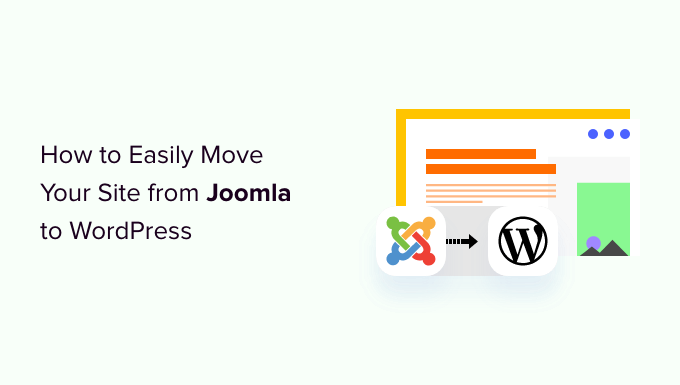
Warum von Joomla zu WordPress wechseln?
Joomla und WordPress sind Open-Source-Software, die in der Programmiersprache PHP geschrieben sind. Sie verwenden die MySQL-Datenbank und haben ähnliche Hosts-Anforderungen.
Allerdings ist Joomla komplizierter zu bedienen, und es gibt weniger Erweiterungen und Designs.
Andererseits ist WordPress der beliebteste Website-Baukasten der Welt. Es ist einfacher zu bedienen und bietet eine Vielzahl von Erweiterungen und Designmöglichkeiten. In unserem Vergleich zwischen Joomla und WordPress finden Sie weitere Einzelheiten.
Wenn wir von WordPress sprechen, meinen wir die selbst gehostete Plattform WordPress.org und nicht WordPress.com. Ja, es sind zwei sehr unterschiedliche Plattformen.
WordPress.com ist eine gehostete Lösung, die begrenzte Funktionen von WordPress bietet, während WordPress.org die berühmte Plattform ist, die jeder liebt und nutzt. In unserem vollständigen Vergleich zwischen WordPress.com und WordPress.org finden Sie die wichtigsten Unterschiede, aber kurz gesagt, Sie sollten WordPress.org verwenden.
Nun, da das gesagt ist, lassen Sie uns einen Blick darauf werfen, was Sie brauchen, um eine Joomla-Website nach WordPress zu verschieben:
Schritt 0: Erste Schritte
Die Anforderungen für Joomla und selbstgehostetes WordPress sind recht ähnlich. Sie benötigen einen Domainnamen und ein WordPress-Hosting-Konto, um mit WordPress zu beginnen.
Wahrscheinlich haben Sie bereits einen Domänennamen und ein Website-Hosting-Konto für Ihre Joomla-Website. Sie können diese auch für Ihre WordPress-Website verwenden.
Wenn Sie zu einem anderen Hosting-Anbieter wechseln möchten, empfehlen wir Ihnen Bluehost.

Bluehost ist eines der besten Hosting-Unternehmen der Welt und ein offiziell empfohlener WordPress-Hosting-Anbieter.
Außerdem können WPBeginner-Leser bis zu 61 % Rabatt auf das Webhosting bei Bluehost erhalten, was einen kostenlosen Domainnamen und ein SSL-Zertifikat beinhaltet. Im Grunde können Sie für nur 1,99 $ pro Monat loslegen.
Hinweis: Wir von WPBeginner glauben an volle Transparenz. Wenn Sie sich über unseren Empfehlungslink bei Bluehost anmelden, erhalten wir eine kleine Provision, ohne dass Ihnen zusätzliche Kosten entstehen (Sie sparen sogar Geld und erhalten eine kostenlose Domain + SSL-Zertifikat). Wir würden diese Provision für die Empfehlung eines beliebigen WordPress-Hosting-Dienstes erhalten, aber wir empfehlen nur Produkte, die wir persönlich nutzen und von denen wir glauben, dass sie unseren Lesern einen Mehrwert bieten.
Schritt 1: WordPress installieren und einrichten
WordPress ist berühmt für seine 5-Minuten-Installation. Viele gute WordPress-Hosting-Unternehmen installieren WordPress automatisch für Sie. Sie können aber auch 1-Klick-WordPress-Installationsprogramme in Ihrem Hosting-Konto-Dashboard finden.
Wenn Sie sich für ein Bluehost-Konto angemeldet haben, wird WordPress automatisch für Sie installiert. Klicken Sie einfach auf die Schaltfläche „Site bearbeiten“ neben Ihrer Website in Ihrem Hosting-Konto.
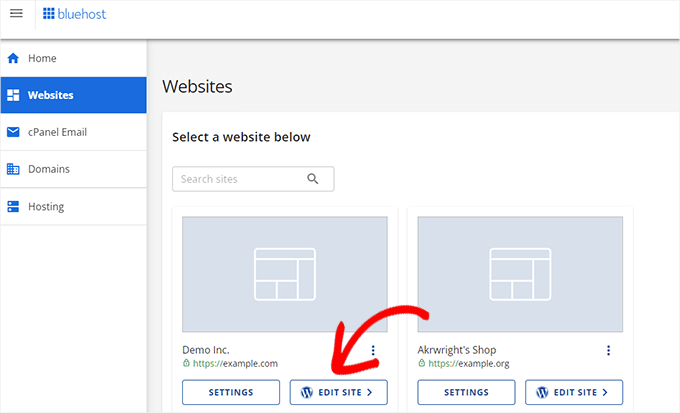
Dadurch gelangen Sie zum WordPress-Administrationsbereich.
Es wird so aussehen:
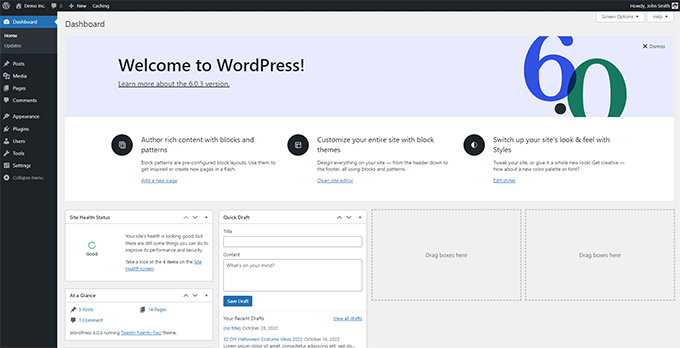
Benötigen Sie weitere Anweisungen? In unserem vollständigen WordPress-Installationstutorial finden Sie eine Schritt-für-Schritt-Anleitung.
Schritt 2: Importieren Sie Ihre Joomla-Website in WordPress
Jetzt, wo Sie WordPress installiert haben, können Sie Inhalte von Ihrer Joomla-Site importieren.
Installieren und aktivieren Sie zunächst das FG Joomla to WordPress-Plugin. Weitere Details finden Sie in unserer Schritt-für-Schritt-Anleitung für die Installation eines WordPress-Plugins.
Rufen Sie nach der Aktivierung die Seite Tools “ Importieren in Ihrem WordPress-Dashboard auf. Dort sehen Sie eine Liste der Import-Tools, die für Ihre WordPress-Installation verfügbar sind. Klicken Sie auf den Link „Importer ausführen“ unter dem Joomla-Importtool (FG).

Dadurch wird das Skript für den Joomla-Importer (FG) gestartet, und Sie werden aufgefordert, die Daten Ihrer Joomla-Website anzugeben.
Zuerst müssen Sie die URL Ihrer Joomla-Website und dann die Datenbankeinstellungen eingeben.
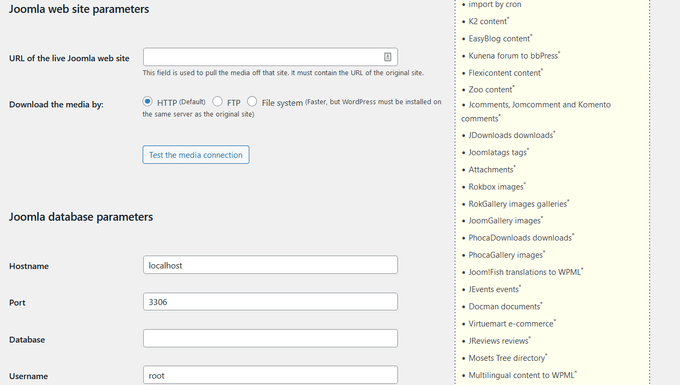
Sie können Ihre Datenbankinformationen im Verwaltungsbereich Ihrer Joomla-Website finden.
Gehen Sie einfach auf die Seite System “ Globale Konfiguration und klicken Sie auf die Registerkarte „Server“.
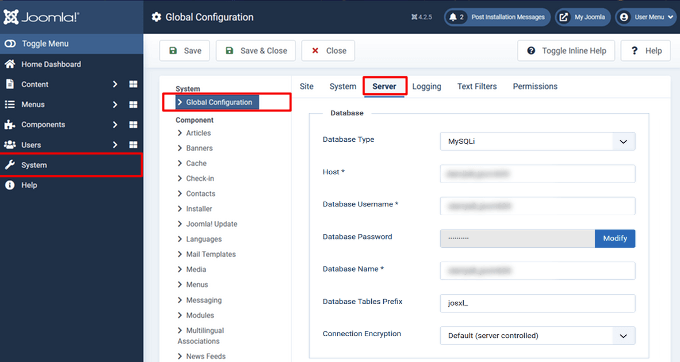
Auf dieser Seite werden alle notwendigen Datenbankinformationen angezeigt, wie z.B. der Benutzername der Datenbank, der Name der Datenbank, das Präfix der Datenbanktabellen, usw.
Die einzige Information, die nicht angezeigt wird, ist das Datenbankpasswort. Wenn Sie sich nicht mehr an Ihr Joomla-Datenbank-Passwort erinnern können, finden Sie es in der Datei configuration.php im Stammverzeichnis Ihrer Joomla-Website.
Sie können auf diese Datei zugreifen, indem Sie sich mit einem FTP-Client mit Ihrer Website verbinden und sie in einem Texteditor wie Notepad öffnen.
Nachdem Sie Ihre Datenbankinformationen in den Joomla-Importer eingegeben haben, klicken Sie auf die Schaltfläche „Datenbankverbindung testen“. Wenn alles korrekt eingegeben wurde, erhalten Sie eine Erfolgsmeldung.
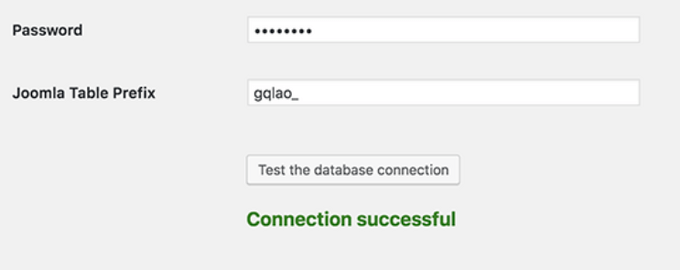
Unten finden Sie weitere Optionen, mit denen Sie bestimmen können, was Sie importieren möchten, einschließlich der Bilder, die im Mittelpunkt stehen, der Inhaltsbilder und mehr. Wenn Sie unsicher sind, lassen Sie diese Optionen unverändert.
Klicken Sie auf die Schaltfläche „Importer starten/fortsetzen“, um fortzufahren.
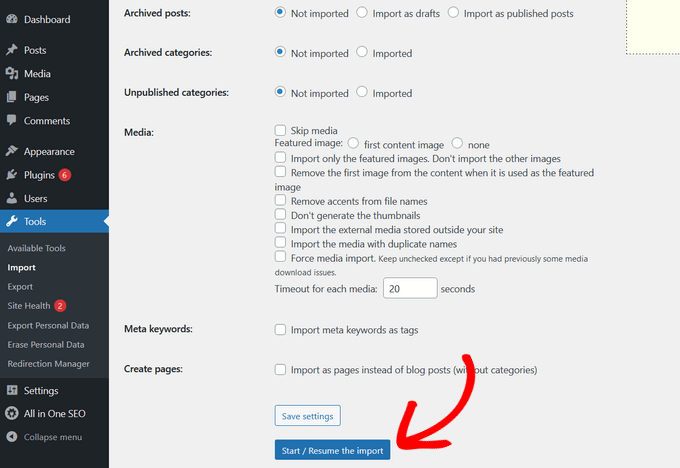
Der Importer wird nun beginnen, Inhalte von Ihrer Joomla-Website zu holen. Dies kann eine Weile dauern, je nachdem, wie viele Inhalte Sie haben.
Sobald dies geschehen ist, wird eine Erfolgsmeldung angezeigt.
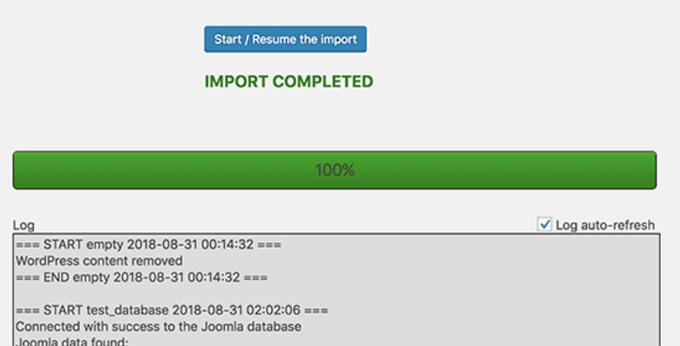
Nachdem Sie nun den Inhalt in Ihre WordPress-Website importiert haben, müssen Sie als Nächstes die internen Links überprüfen, die möglicherweise auf Ihre alte Website verweisen. Der Joomla FG-Importer wird auch das für Sie beheben.
Sie müssen nach unten scrollen und auf die Schaltfläche „Interne Links ändern“ klicken.
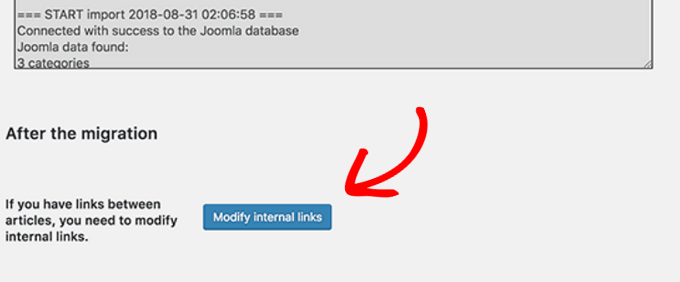
Sie können nun Ihre WordPress-Website besuchen, um die importierten Inhalte in Aktion zu sehen.
Was ist nach der Umstellung von Joomla auf WordPress zu tun?
Nachdem Sie Ihre Website von Joomla auf WordPress umgestellt haben, müssen Sie noch ein paar Anpassungen vornehmen, um den WordPress-Migrationsprozess abzuschließen und Ihre neue Plattform einzurichten.
Schritt 3: Umleitungen und Permalinks einrichten
Ihre alte Joomla Website hat möglicherweise eine andere URL-Struktur als Ihre WordPress Website. Das bedeutet, dass Menschen, die Ihre Artikel in Suchmaschinen finden, jetzt eine 404 Fehler Seite sehen.
Um dies zu beheben, müssen Sie Permalinks einrichten und Benutzer und Suchmaschinen ordnungsgemäß auf die neuen URLs umleiten.
Zuerst müssen Sie die Seite Einstellungen “ Permalinks in WordPress aufrufen. Klicken Sie unter dem Abschnitt „Allgemeine Einstellungen“ auf die Option „Beitragsname“.
Klicken Sie dann auf die Schaltfläche „Änderungen speichern“.
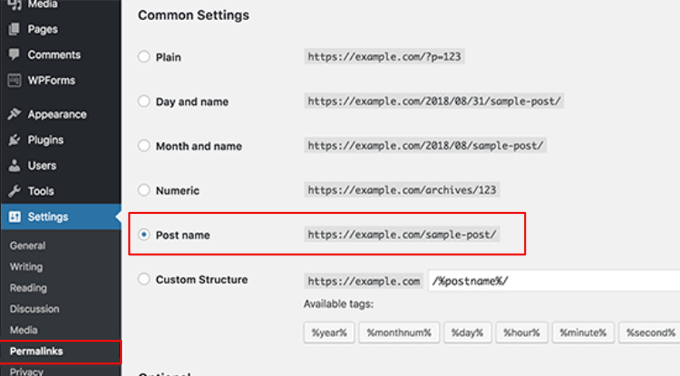
Um Weiterleitungen einzurichten, müssen Sie als Nächstes das Umleitungs-Plugin auf Ihrer WordPress-Website installieren und aktivieren. Weitere Einzelheiten finden Sie in unserer Schritt-für-Schritt-Anleitung zur Installation eines WordPress-Plugins.
Nach der Aktivierung müssen Sie die Seite Tools “ Redirection aufrufen.
In das Feld „Quell-URL“ geben Sie Ihre alte Joomla-URL ein, und in das Feld „Ziel-URL“ geben Sie Ihre neue URL ein, wie in der Abbildung unten gezeigt.

Stellen Sie sicher, dass Sie die Option „301 – Moved Permanently“ auswählen und klicken Sie dann auf die Schaltfläche „Add Redirect“, um Ihre Änderungen zu speichern.
WordPress wird nun die alte Joomla-Website-URL auf Ihre neue WordPress-Permanentstruktur umleiten.
Wiederholen Sie den Vorgang, um Weiterleitungen für andere Seiten oder Beiträge hinzuzufügen. Denken Sie daran, die alten URLs zu besuchen, um sicherzustellen, dass sie ordnungsgemäß auf die neuen URLs auf Ihrer WordPress-Website umgeleitet werden.
Weitere Einzelheiten finden Sie in unserer Anleitung zum Einrichten von Weiterleitungen in WordPress.
Als Alternative können Sie auch All in One SEO (AIOSEO) verwenden, um Seiten und Beiträge von Joomla zu WordPress umzuleiten. AIOSEO verfügt über einen leistungsstarken Redirection Manager, mit dem Sie komplette Weiterleitungen einrichten können.
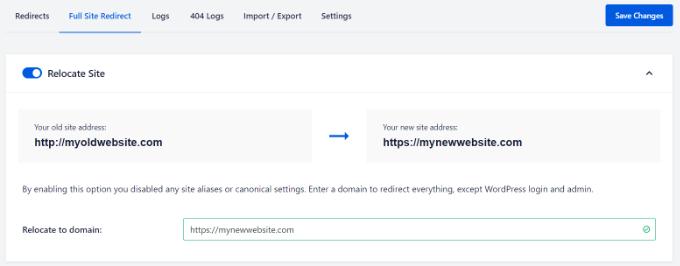
AIOSEO bietet auch eine 404-Fehlerverfolgung, um fehlerhafte Links, die beim Umzug Ihrer Website von Joomla zu WordPress auftreten können, leicht zu erkennen.
Weitere leistungsstarke Funktionen sind unbegrenzte Schlüsselwörter, Schema-Markup, benutzerdefinierte Breadcrumbs, lokale SEO-Module, WooCommerce SEO und mehr.
Schritt 4: WordPress-Theme einrichten
WordPress bietet Ihnen Zugang zu einer riesigen Sammlung von Themes, die Sie verwenden können. Themes bestimmen das Aussehen und Design Ihrer WordPress-Website.
Es gibt Tausende von kostenlosen und kostenpflichtigen WordPress-Themes, die Sie auf Ihrer neuen WordPress-Website installieren können. Allerdings sind nicht alle Themes für alle Arten von Websites geeignet, und diese Fülle an Auswahlmöglichkeiten kann Anfänger ein wenig verwirren.
Wir haben dies durch unsere Recherche und die Auswahl der besten WordPress-Themes erleichtert. Hier sind einige unserer Theme-Showcases, die Sie besuchen können, um das perfekte Theme für Ihre Website zu finden:
- Beste kostenlose WordPress-Blog-Themes
- Beste WordPress-Business-Themes
- Die besten minimalistischen WordPress-Themes für Redakteure
- Beste WordPress-Themes im Magazin-Stil
- Beste WordPress-Themes für Fotografen
Brauchen Sie Hilfe bei der Installation Ihres neuen Themes? Sehen Sie sich unsere Anleitung für Anfänger an, wie man ein WordPress-Theme installiert.
Schritt 5: Installieren Sie wichtige WordPress-Plugins
Plugins sind der beste Teil der Verwendung von WordPress. Mit WordPress-Plugins können Sie Ihrer Website neue Merkmale und Funktionen hinzufügen.
Sie können WordPress-Plugins für Backups, zur Verbesserung der Sicherheit, zum Einrichten von Caching, zur Einrichtung eines eCommerce-Shops, zur Optimierung Ihrer Suchmaschinen und vieles mehr verwenden. Wenn Ihnen eine Funktion einfällt, ist die Wahrscheinlichkeit groß, dass es dafür bereits ein WordPress-Plugin gibt.
Es gibt Tausende von kostenlosen und kostenpflichtigen WordPress-Plugins und Add-ons, die Sie verwenden können. Da es leicht ist, von der Auswahl überwältigt zu werden, haben wir einen ultimativen Leitfaden erstellt, um die besten Plugins für Ihre Website auszuwählen.
Um Ihnen noch mehr zu helfen, finden Sie hier einige der besten Plugins, die wir empfehlen, auf Ihrer neuen WordPress-Website zu installieren:
- WPForms – Der beste WordPress-Formular-Builder, der es einfach macht, Kontaktformulare, Zahlungsformulare, Registrierungsformulare, Umfragen und mehr zu erstellen.
- SeedProd – Ein leistungsstarker Drag-and-Drop-Website-Builder für WordPress. Sie können damit individuelle WordPress-Themen und Seitenlayouts erstellen. Es ist keine Codierung erforderlich.
- AIOSEO – Eines der beliebtesten SEO-Plugins für WordPress. Es hilft Ihnen, Ihre gesamte Website für bessere Suchmaschinen-Rankings in weniger als 10 Minuten zu optimieren.
- MonsterInsights – Das beste Analyse-Plugin für WordPress, das Sie wissen lässt, wie viele Besucher auf Ihre Seite kommen, woher sie kommen und was sie auf Ihrer Seite tun.
- OptinMonster – Ein leistungsstarkes Toolkit zur Optimierung der Konversion, mit dem Sie Website-Besucher in E-Mail-Abonnenten und Kunden verwandeln können.
Weitere Plugin-Empfehlungen finden Sie in unserer Liste der wichtigsten WordPress-Plugins, die Sie auf allen Ihren WordPress-Websites installieren sollten.
Schritt 6: WordPress lernen
Wenn Sie kein WordPress-Experte sind, dann machen Sie sich keine Sorgen. WordPress ist ziemlich einfach zu bedienen. Dennoch kann es vorkommen, dass Sie auf neue Dinge stoßen, die Sie lernen müssen. Hier kann WPBeginner helfen.
WPBeginner ist die größte WordPress-Ressourcenseite für Anfänger. Wir haben viele hilfreiche Inhalte, die speziell für Anfänger, Geschäftsinhaber und Blogger erstellt wurden.
Im Folgenden finden Sie einige der hilfreichen Ressourcen, die Sie auf WPBeginner finden können (alle sind völlig kostenlos):
- WPBeginner Blog – Der zentrale Ort für alle unsere WordPress-Tutorials und -Anleitungen.
- WPBeginner Dictionary – Unser WordPress-Glossar ist der beste Ort, um sich mit dem WordPress-Jargon vertraut zu machen.
- WPBeginner Videos – Neue WordPress-Benutzer können mit diesen Videos beginnen, um WordPress zu beherrschen.
- WPBeginner auf YouTube – Brauchen Sie mehr Videoanleitungen? Abonnieren Sie unseren YouTube-Kanal, der mehr als 300.000 Abonnenten und über 56 Millionen Aufrufe hat.
- WPBeginner Blueprint – Sehen Sie sich die Plugins, Tools und Dienstleistungen an, die wir auf WPBeginner verwenden.
- WPBeginner Deals – Exklusive Rabatte auf WordPress Produkte und Dienstleistungen für WPBeginner Nutzer.
Viele unserer Nutzer verwenden Google, um Antworten auf WPBeginner zu finden, indem sie einfach „wpbeginner“ am Ende ihrer Suchbegriffe hinzufügen.
Wir hoffen, dass dieser Artikel Ihnen beim Umzug Ihrer Website von Joomla zu WordPress geholfen hat. Vielleicht interessieren Sie sich auch für unseren Leitfaden zur Erstellung einer kostenlosen geschäftlichen E-Mail-Adresse und unsere Auswahl der nützlichsten Tools zur Verwaltung und Erweiterung Ihrer WordPress-Website.
Wenn Ihnen dieser Artikel gefallen hat, dann abonnieren Sie bitte unseren YouTube-Kanal für WordPress-Videotutorials. Sie können uns auch auf Twitter und Facebook finden.





Syed Balkhi says
Hey WPBeginner readers,
Did you know you can win exciting prizes by commenting on WPBeginner?
Every month, our top blog commenters will win HUGE rewards, including premium WordPress plugin licenses and cash prizes.
You can get more details about the contest from here.
Start sharing your thoughts below to stand a chance to win!
Joseph Matt says
I really appreciate this content as it’s insightful. However, I noticed you did not talk about the domain which we are supposed to install the wordpress before importing Joomla website.
I’m asking this because I want to move my website from Joomla to WordPress however, I still want to maintain my domain name. It is also not possible to install to CMS on a domain though, I noticed the tutorial states that Joomla website must be live for the importation to work.
My Question: How do I move from Joomla to WordPress while still maintaining my Joomla domain name on the new WordPress website.
Thanks as I await your response.
WPBeginner Support says
For that, we would recommend checking with your hosting provider as some have a temporary URL or a staging site option that would allow you to set up the site without moving your domain name. It would depend on the specific host for the method that would need to be used.
Admin
Pantelis says
Great info! What I do not understand is: As we need to pick a theme after the import is complete why migrate the website and not built it from scratch in the selected WordPress theme. What do we win from the migration? Thank you
WPBeginner Support says
It would depend on how much content is on your site, the export attempts to move the content while the theme styles your content.
Admin
Laura says
Hi,
this article is definitely what I was looking for given that I was asked to update an old Joomla website and I decided to convert it into a WordPress website.
I have a question: the Joomla website is very old (Joomla version running is 1.5.25). Would this technique work even with such an old version of Joomla?
Thank you very much for your useful articles!
WPBeginner Support says
We have not tested with older versions at this time but it should work.
Admin
Shahidul Islam says
Thanks for share this helpful article.
If I migrate my Joomla site to WordPress then my all products will transfer from Joomla to WordPress or only the content & media will transfer on WordPress
WPBeginner Support says
It would depend on how the products were added. If you reach out to the plugin’s support they can let you know if those products are transferred
Admin
Igor says
hi, can i deactivate and delete plugin after finishing?
WPBeginner Support says
You should be able to remove the importer once you have completed your transfer.
Admin
Mustafa Kamal says
is there any way to migrate the template too?
WPBeginner Support says
Not at the moment
Admin
Yash says
I have a question, can i migrate my joomla site to wp locally?
WPBeginner Support says
You can certainly move your content from Joomla to a local WordPress site if you wanted.
Admin
Klyde says
Can we use this conversion process if the website has more than one version of Joomla on it? It looks like ours (I am new) has mostly 2.5.0 but some components, modules, etc. are lower or higher.
WPBeginner Support says
Unless we hear otherwise, it should still work. You can always test using a local installation on your computer: https://www.wpbeginner.com/how-to-install-wordpress/#installlocal
Admin
Caroline says
Our current website was built in Joomla years ago and we want to revamp it in WordPress.
We want to keep the current domain name but we don’t want to keep the old Joomla content; instead we prefer to start fresh since most of the content is outdated, anyway. That said, I’d like to keep the old website „live“ until the new website is ready to publish.
Do I still need to technically „move“ the site from Joomla to WordPress or can I just change the platform from Joomla to WordPress without importing the content?
WPBeginner Support says
If you don’t want to keep the content then you could create your WordPress site from scratch without worrying about your content. You would just point the domain name to your host once you are ready for the new site to be live.
Admin
uysy says
Hi WPB Team,
I want to migrate my joomla site to WP. But I don’t have option to backup my Joomla site before i start migration to WP.
Does WP plugin change anything on Joomla site during migration? Or this is only straight copy > to WP site?
WPBeginner Support says
It should only be copying your content from Joomla
Admin
Javier Eraso says
Your guide is very useful for those who decided to migrate from one CMS to another. However, it is not accurate to say that Joomla is not as powerful or flexible as WordPress. I’ve been working with both for many years now and I can say that you are wrong. The fact is that WordPress is simply more popular and perhaps slightly easier to setup for very novice user with very basic functionality. It is like the Windows vs. Linux discussion.
WPBeginner Support says
Thanks for sharing your opinion on the difference between the two
Admin
Brad says
Joomla was the platform we originally built upon, yet the difficulty with imbedding a customizable favicon became a real issue as the website looked incomplete, amateurish, with the seemingly unchangeable default favicon (a Joomla logo). Other WordPress websites of ours easily customize favicon images, thus we have elected to go all WordPress at this time.
Your post is a tremendous resource. Thank you!
WPBeginner Support says
Thank you, glad our content was helpful
Admin
Vinny Hebert says
How can you tell people that Joomla is not powerful or flexible? At Joomla’s core, it is more powerful and flexible than WordPress and more secure.
WPBeginner Support says
We do not say that it is not flexible or powerful, it is our opinion that WordPress is MORE powerful, flexible, and user-friendly
Admin
Ronny Fretel says
How about a multilingual joomla site?? will WordPress support this?
WPBeginner Support says
Hey Ronny,
WordPress can be multilingual using third-party plugins. We are not sure if those plugins would be able to recognize and sort multilingual content from another platform.
We would suggest that you import your Joomla site to a WordPress installed on local server first.
Admin
Giulio says
Hello! Thank you for the great article.
I have a Joomla website that I want to migrate to WP. I have no subdomains available and I want to install WP on a subdirectory of the website, then install the plugin, import all the Joomla data into WordPress and finally change WP installation from the subdirectory to the principal root.
Do you think it’s a good way to do it?
WPBeginner Support says
Hi Giulio,
It will work. You can also import your Joomla website to a local install set everything up and then move it to live server.
Admin
Gjergji Kokushta says
Thank you for the article, but I do have a question: MySite has Joomla installed. As I understood, I need to have another domain+hosting where WordPress is intalled, so I can migrate from MySite.com to MyNewSite?
Is there a way to do it within the same hosting account?
WPBeginner Support says
Hi Gjergji Kokushta,
Please contact your hosting provider. Many Joomla hosting providers also support WordPress. In fact, your account may already be fully ready to install WordPress. However, if it is not, then you will need to move but you still wouldn’t need to change domain names as you can point your existing domain to your new WordPress website.
Admin
Faust says
you have to test these migration settings on a staging server if there is issues involved.
Sarah Clarke says
I successfully moved my site from Joomla to WordPress. Thanks for sharing this important piece of information.
monu says
I am very new to this field. I want to transfer my joomla website to wordpress. I have 3 domains parked on 1 hosting. When I installed wordpress for one of my domain which was working on joomla already, other website started working strangely.
Can anyone assist me what should I do to use wordpress in place of joomla.
clare says
Converting a hacked joomla site. Will this bring over the nasty that infected it?
Helene says
How is the current existing WordPress site affected by the import of Joomla data? Do photos transfer over without premium?
Does having a copy of the imported data live on another domain affect SEO?
Thanks so much WPBegginner you guys have been so great!!
Helene, WPnewbie
xain says
i have a lot of products in my joomla website and i want to move them to my wordpress site and i want to keep links for seo…
How can i move the products not articles?
kindly help with it
Thanks
Amin says
Hi
I have question, i have a lot of products in my joomla website and i want to move them to my wordpress site and i want to keep links for seo…
How can i move the products not articles?
Faisal says
Hello All,
I am completely new in this field. I find one classified template on Joomla. and its almost related to my requirement. they using plugins for DJ-monster.
I am new on this. I want to start my classified web business on wordpress using woocommerece. can I use joomla classified template offline in my laptop and then transfer it in to wordpress or not. with DJ-monster plugins.
this is the joomla template which i want to use.
please your answer and guidelines will make life easier. as I am only the one person who investing limited budget on this business.
many thanks in advance
regards
faisal
Alen says
Hello,
great stuff shown here.
I have a question. Is it possible to somehow „migrate“ from joomla to wordpress if the joomla version is no longer online? I have everything stored locally.
Thanks
WPBeginner Support says
Yes, there might be a few hiccups but its possible. Try to import your old joomla site into a WordPress installed locally first.
Admin
Josh says
Hey WPBeginner thanks for a great article!
I plan on moving my site from Joomla to WP but most pages on the Joomla site has a .html extension on the end of the URL.
From my research it seems that it’s hard or not possible for WordPress pages to have .html extensions, only posts.
Is there a way around this or should I just migrate the content and create the pages without the .html extension on the URL? I’m scared this will effect rankings and will take some time to get indexed by Google.
Regards
Josh
Abhi says
Hi you can use wordpress plugins to have .html extension of page and posts
like the below one :
Add HTML Extension to Specific Pages
this may solve your problem
Cheers… (y)
Moshe says
I want to migrate a decent size online magazine that’s on Joomla to WP,
Can you recommend someone that can do the actual migration for me?
Moshe
John Loty says
thanks for the article…I have, on the Joomla site, a customized theme/template…(home page)…Not sure of the correct term…I am assuming that I have to select or create a WP theme on the fresh WP site and that the import process will fit what it can and that I will have to make „adjustments“ to get it all into WP?
Is there a particular step to prepare for receiving content that was in the customized theme on Joomla? Ta
WPBeginner Support says
WordPress comes with a couple default themes pre-installed. The latest of the default themes will be automatically activated on your site when you install WordPress. You can import content from your Joomla site and then adjust or change your WordPress theme.
Admin
FAD says
Hi John,
There is a way. you must need to implement and activate the theme and installed.
Post that, you can see the latest imported content and with new layout.
Let me know, if any help required.
Chad says
Hi There, will this plugin allow me to import my members list from Joomla to WordPress?
Michael says
Any answer here? Can I import the member list from Joomla to WordPress if I use this plug-in?
FAD says
Hi MICHAEL,
Yes, you can import members. Might need to go for premium plugin.
Let me know, if any doubts.
Regards,
FAD.,
Arbel Martin says
This looks great!
Was wondering if by importing the Joomla site, if it erases all the data from the Joomla site.
For instance,
I would like to create a copy of the joomla site on a test WordPress domain and edit it. Once the site is ready to replace the original Joomla site, then I would point it to the WordPress site.
Would this be possible with this method?
Thank you!
-Arbel
Helene says
Did you get an answer?
Thanks!! ☺
Helene
Riska Glenn says
Thanks for sharing, this article help me to migrating
I was install wordpress on mydomain/dir and completely import content from Joomla using FG joomla to wordpress plugin. My question, how to move all content and database to public directory?
Did you have article about it?
Thanks before
Lyle says
Thank you so much for the link to the FG Joomla! to WordPress plugin!
Worked like a charm to import my 292 J! articles into my WP posts. Easy, quick and perfect!
jyoti says
which version are you talking about?
Abdo says
my is Joomla 2.5 and the import required a password..where i can find
Laureleye says
Do modules transfer with the other content? If not, do you have any recommendations on how to transfer modules from Joomla to a WordPress page?
Scott says
I don’t think this is possible.
WPBeginner Staff says
Yes, once you have imported your content from you can delete the importer plugin.
hummble says
Again, might be a silly question but I am new-ish to WP. I have my site all migrated and set up with content (mostly) as I want it for now. Moved my old joomla site to a protected folder on the same server just in case I should ever need to refer to it again.
Now my plugin manager keeps bugging me that there is a new version of the Joomla to WordPress available. But I shouldn’t need that, right? I’m all done with it. Can I delete the plugin without messing with the data it migrated for me?
sushant says
can i migrate database from joomla to wordpress? If so, how?
Ru says
if i import my website from Joomla to WordPress, the Joomla site will exist or will be automatically deleted?
prabin04 says
well, import doesn’t mean move .. so your site will exist
WPBeginner Staff says
You will need access to either phpMyAdmin on the server, or FTP access to modify configuration file.
Johny says
May be dumb question but I only have access to Joomla Admin panel, not the installation directory. Is there a way to find DB password from admin panel without having access to configuration file?
Perry Mensah says
You can install an extension for joomla file system. com_extplorer can do it for you.
WPBeginner Staff says
Linda at the end of the import process you can fix your internal links by clicking on the modify internal links button.
linda says
maybe a dumb question, but how do I make the url go to my new wp-site instead of my old-joomla one? I guess I have to change that somewhere in my webhosting. But where?
Karen says
Are there any issues with moving a Joomla site to WordPress on my local server to do development and then moving the new site back to replace the old site?
Kuba says
Only 1 item imported but joomla site contain many articles. My Joomla version is 3.2.1
H. Olden says
This is a great add to your articles and it worked like a charm. In fact, imported 5 years of data off my old Joomla 1.5 install and brought the site back up on WP. Thanks for posting…
WPBeginner Support says
We are glad that you found it useful. Thanks for the feedback.
Admin
Dani M says
Do you know if there is a way of exporting the look and feel of the site not just the info?
chrys says
Hi,
I read in the previous comments that it’s better to have a new database when migrating on the same server. But what does it mean? If my host only provide me with one database, I’ll buy another and when I install wordpress in a new directory I give the details of the new database and when migrating joomla I give the joomla database code in the plugin. Thoses database are completely independent aren’t they? Then I move up the wordpress directory at the root and I’m done? All my content will have gone on my new database won’t it?
By doing that, assuming I have kept the same domain name, I guess only my wordpress site will be live, but what about the old links that are still visible on google? Don’t I risk a duplicate content and be blacklisted? i’m a bit confused..
Thanks !
crooso says
i have joomla site, i need convert all them to wordpress.
can i do export ALL THE THINGS into wordpress without deleting joomla site,
WPBeginner Support says
Yes you can and you should first import everything in WordPress. If you deleted your Joomla site before starting then you will not be able to import anything.
Admin
babu says
hi iam nagababu i want to Migrate my existing Joomla website (1.5) to WordPress and i have one question can you please help me
First what i have to do
may i need to uninstall Joomla and fresh installation Of wordpress in existing domain
Can you please clarify this
WPBeginner Support says
If you have joomla installed on the location where you would want to install WordPress then the best way to go is to create a new directory and then install WordPress in that directory. Once you have successfully migrated your Joomla site you can change your Domain’s settings to point to to the directory where WordPress is installed.
Admin
Kannan says
Hi there,
When you say a new directory, do you mean a new folder under public_html? Thank you.
WPBeginner Support says
Yes.